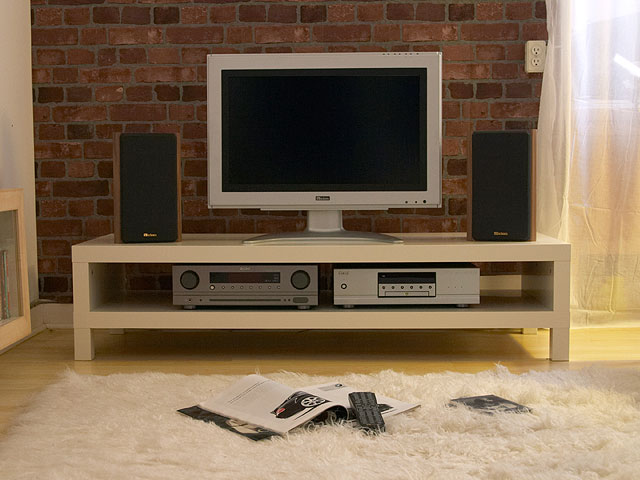Next to choosing your loudspeakers, selecting the right receiver, be it a Dolby Digital/dts 5.1, 6.1, or 7.1-channel surround-sound A/V model or a simple 2-channel stereo unit, is almost as important because you have to contemplate future needs and how much power and versatility you're willing to pay for.
The receiver serves as the control unit, switching and amplification center for your entire system (it's a "receiver" because it contains a built-in AM/FM radio tuner). If it lacks an AM/FM tuner, it would be an "integrated amplifier," or just plain "amp," for short. The receiver and its remote control let you select which source to listen to (CD player, FM tuner, tape deck, VCR, or DVD player) or watch (if it's an audio-video receiver). When you press "CD" on the remote, the receiver internally switches its amplifiers to the incoming signal from your CD player, passes those signals through its control section (tone, balance and volume controls), then to its built-in amplifiers and sends the greatly strengthened audio signals to your speakers (and the accompanying video signal to your TV, if you selected "DVD" or "VCR" on an A/V receiver).
First, however, you must choose whether to get a simple stereo receiver that has two internal amplifiers to drive a pair of speakers, or instead, an A/V surround-sound unit that will have a minimum of five internal amplifiers to drive five speakers in your room: the left and right main speakers up front, a center-channel speaker atop your TV, and two surround speakers on the side walls. The sixth or ".1" channel, as in "5.1," is for just deep bass and low-frequency soundtrack effects. That Low-Frequency Effects (LFE) ".1" channel is sent to your subwoofer, which almost always has its own internal amplifier. Surround-sound A/V receivers also have internal digital decoders to sort out the DVD player's Dolby Digital or dts digital 5.1-channel soundtrack.
In recent years, 5.1-surround sound has evolved to 7.1 surround speakers, adding an extra two surrounds to really complete the effect of envelopment.

By comparison, stereo receivers are blessedly simple-just two internal amplifiers, no surround sound circuitry, and two pairs of speaker output connectors for the left and right channels. That still appeals to some buyers. However, prices of surround-sound 7.1-channel A/V receivers have become so competitive that they cost little more than a basic 2-channel stereo model. So consider very carefully whether or not you're planning a home theater system for a future (or bigger) home or if you want plain old vanilla stereo. Moreover, if you think that at some point in the future, you might be persuaded by the sheer pleasure of surround sound then now is the time to go for a multi-channel A/V receiver. Any A/V receiver is usable in a pure stereo form if you wish, with or without an accessory subwoofer. In most units, you simply hit a button on the remote labeled "Surround Off" to switch back to a stereo 2-channel mode.
The rated power output of the receiver's internal amplifiers, stated in watts per channel into 8 ohms, will ultimately determine the unit's selling price. The more power you buy, the more costly the receiver. But "solid-state" (transistor) amplifiers are very economical. You can find stereo receivers with 80 or 100 watts or more per channel for as little as $300. A/V surround receivers with similar power also start at this price level. Don't scrimp on the power: the greatest source of damage to speakers is using too small amplifiers to drive speakers at high volumes, especially when you might "crank it up" at a party. The amp runs out of watts, distorts, and the distorted signal burns out tweeters or woofers in seconds. And one basic truth most consumers do not understand when they are shopping for amps and speakers: smaller speakers generally require more power-not less-to produce realistic volume levels than big speakers do because they use smaller woofers and are less efficient.
In all but very large living rooms or those with cathedral ceilings and volumes of 6,000 to 7,500 cubic feet, receivers with 80 to 100 watts output per channel to all five channels will be sufficient for most listeners who like fairly loud music with movie soundtracks or CDs. Listeners used to insanely loud volume levels with large floorstanding speakers should look at separate power amplifiers with 200 to 350 watts per channel. Modest little 35-watt amplifiers may be OK for a den or a dorm but they just can't cut it in an average living room unless you're going to listen at background levels. And background levels are strictly low fidelity - we don't go to a concert and tell the musicians, "Hey, play really quietly!"
Now you know what it is . . . so what do you need? Click here to send an email directly to Alan Lofft for an expert recommendation based on your room size and listening preferences, or contact us toll-free at 1-888-352-9466 for fast, free, friendly advice.





